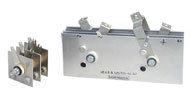

- #REPLACING A SELENIUM RECTIFIER WITH A SILICON DIODE PC#
- #REPLACING A SELENIUM RECTIFIER WITH A SILICON DIODE SERIES#
- #REPLACING A SELENIUM RECTIFIER WITH A SILICON DIODE TV#
- #REPLACING A SELENIUM RECTIFIER WITH A SILICON DIODE WINDOWS#
The HV board replaces the half-wave rectifier with a SiC bridge and uses 25uF/600V PP film caps to replace the 4-section aluminum electrolytic can."That piqued my interest for a moment, but only a moment.

The new LV circuitry uses SiC rectifiers, 10,000 hr 105C Low Z electrolytic filter cap, sophisiticated Common mode filtering to eliminate rectifier pulses capacitively coupled from the high-voltage winding of the power transformer, and an adjustable low-noise regulator to set the filament voltage correctly at the tube. These rectifiers gradually die over the years and the filament supply was putting out 3.2V instead of 6.3V.

The LV board replaces the unregulated filament supply fed by FWCT selenium rectifiers.
#REPLACING A SELENIUM RECTIFIER WITH A SILICON DIODE PC#
I have designed 2 PC boards that will occupy the space previously taken up by the huge twist-lock electrolytics. "My current project is the rework of several Altec 525A power supplies for the Lipstik vacuum tube mics. Anyway, it contains the words "gear" and "real")!: I did stumble upon this intriguing post on "**************," a forum I had not previously encountered (hm, don't know why that was redacted. Thanks Lotus! I figured as much but not having encountered "fancier" diodes before I wondered if there was something I was missing. Being relatively low current and having resistors which will act to lower current peaks these may not be necessary. You may also need to consider 'snubber' capacitors (typically 0.05uF or thereabouts) across each diode as 'silicon' diodes 'switch' much faster than Selenium and could introduce some noise into the audio circuitry. You WILL need either 1 or 2 resistors to 'bulk out' the inherent 'loss' exhibited by the selenium type and this (these) can get pretty warm so a wirewound part possibly bolted to the chassis could be good here. A 600 Volt 8 amp dual diode (probably in a TO220 case) would be practically bullet proof for a replacement of a selenium rated at around 1 Amp. You can always go up in voltage rating, and unless you are making thousands of units, the cost of increased voltage and current rating is only a matter of a Dollar which is worth far more as 'insurance'. These are available in the 'silicon' world too with both common cathode and common anode versions available. And like many capacitors, the older they are the more likely they are to fail.The Selenium type is obvioulsly a 'pair' of diodes in one assembly. I see 76vdc entering the tube and 47.5vdc leaving the tube. I took some measurements at the 50A1 ballast vacuum tube with the info provided by Jeff.
#REPLACING A SELENIUM RECTIFIER WITH A SILICON DIODE SERIES#
I don't like selenium rectifiers, but they often appeared in old electronics as an alternative to vacuum rectifiers because of its "instant on" capability while retaining many of the electrical characteristics equivalent of many vacuum rectifiers. I successfully replaced the selenium rectifier with a silicon diode and a 47ohm 5w resistor in series with the already present 130ohm resistor as suggested by Peter. If the device has a "press fit" chassis mounting, use goggles if you attempt to remove it from its mount. I recommend latex/vinyl gloves and good ventilation. In short: Replace it, but use good safety practices while handling the device. Just to be specific on "selenium dioxide", here's a MSDS on it. Allow the selenium dioxide vapours to dissipate for several days before you go back - you will not want to go back very soon anyway! "
#REPLACING A SELENIUM RECTIFIER WITH A SILICON DIODE WINDOWS#
If you smell something really rotten, like decaying onions and garlic, coming from your equipment, it is best to leave the area immediately, opening some windows on the way out. Fortunately it is not considered a carcinogen.Īnother fortunate thing is the awful smell which gives it away. It can also promote allergic reactions with the skin. It can cause severe burns to the mucous membranes and severe respiratory tract, skin, and eye irritation. Selenium dioxide is the major compound produced when a selenium rectifier is overheated.
#REPLACING A SELENIUM RECTIFIER WITH A SILICON DIODE TV#
From: Safety Hazards in Radio and TV Repair


 0 kommentar(er)
0 kommentar(er)
